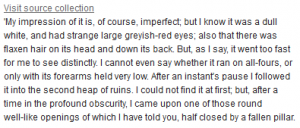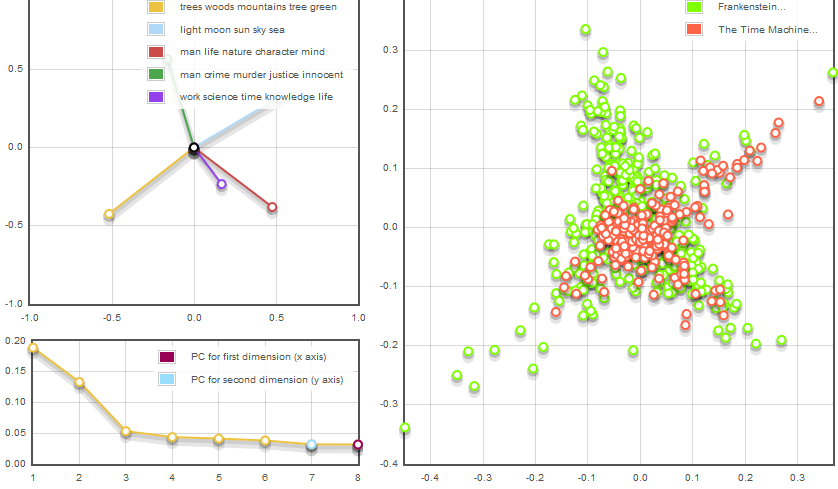Locating Science Fiction in the Gothic with Woodchipper
Posted by on Saturday, April 21st, 2012 at 1:07 pmWhile trying to use Woodchipper to come up with a definition of the Gothic, I was also interested in looking at Gothic literature as spawning numerous forms of popular literature, namely Mystery, Horror, and Science Fiction. Mystery and Horror, at least from the outset, seem like straightforward extensions of elements already present in the Gothic. Science fiction, on the other hand, branches off in different, and I would argue more interesting, ways.
I derive most of my assumptions and questions from this article. Brantlinger focuses on science fiction’s origins in Gothic literature. Like the Gothic, sci-fi questions the limits of rationalization. Both genres emphasize the sublime, namely fear and wonder, to arouse terror. They also favor subjectivity over objectivity, viewing the nature of the universe as essentially unknowable, and therefore we can only determine our own separate accounts; this theme, especially for the Gothic, comes through its epistolary format.
Most importantly, Gothic and sci-fi both take reason to its extreme limit in order to reveal the point where the rules break down. In both genres, this scenario can only lead to disaster. The difference is that for gothic texts, this disaster usually takes place internally, while in science fiction it becomes external. So, in analyzing my findings, another major topic to watch out for would be interiority versus exteriority, and well as the personal versus the societal.
I ran Frankenstein (considered by many to be the first sci-fi novel) and The Time Machine by Wells (one of the fathers of sci-fi) with other Gothic texts and with each other. I also hope to use Verne (the other father of sci-fi) and Poe, who wrote some of the first sci-fi stories and had a huge influence on the genre. I only have enough space here to focus on a few interesting results. Obviously, running two early science fiction / gothic texts alone against thirty or so gothic texts cannot yield definitive results. However, perhaps in conjunction with my own analysis, Woodchipper could offer a useful lens for observing trends between and within these genres, as well as introducing new questions for future runs.
With this in mind, I’ll present my first run: Frankenstein and Caleb Williams:
While there is a fair amount of overlap, Caleb favors the Crime/Justice topic, and what Kathryn categorized as the “Sublime” (“man,” “life,” “nature,” “character,” “mind”), although this is less clear, while Frankenstein leans more toward the “Existential” (or “Spiritual”) topic (“life,” “death,” “existence,” “mind,” “heart”). Does this address my questions? Not so much. On the one hand, most of these categories leans more toward interiority than exteriority. So, from these results, Frankenstein doesn’t offer much evidence for science fiction’s emphasis on the social and even cosmic. On the other hand, these categories also privilege subjectivity (especially “seemed” in an alternate run), which aligns with both the Gothic and sci-fi. But, again, Frankenstein has a lot in common with Caleb, and while they diverge in certain respects, these differences appear to have more to do with each novel’s own respective foci rather than an indication of genre. Moreover, Caleb’s deep engagement with the political (which Frankenstein also shares) may signify the work as atypical of its genre, although Woodchipper only represents this aspect here through the Crime/Justice category (without specifying the type of justice: personal or societal).
Another important note: while many texts in my runs tend to densely populate certain topics, Frankenstein is comparatively scattered. Does this make Frankenstein harder to pin down and categorize than other Gothic texts, and is that a clue that it shares another genre: science fiction? It’s too difficult to tell, especially when none of the topics here clearly points to science fiction.
Turning to The Time Machine, I ran the text with The Beetle, which contains a few supernatural elements, such as shape-shifting:
The Time Machine was difficult to use because its own terms and jargon—“Time Traveller,” “morlocks,” ect.—clutter the results. In this pairing, however, both texts are concerned with observation and information-gathering. Two topics leave room for ambiguity and subjectivity (“seemed” appears in both). The other, “told,” “asked,” “knew,” “see,” “thought,” alludes to more concrete evidence. Interestingly, this is where the texts overlap the most. Thus, at least from this run, it appears that while The Beetle is interested in all forms of observation, The Time Machine is more concerned with objectivity.
Choosing a random sample passage quickly complicates this tentative conclusion, however.
The Time Traveller’s privileging of objective reality (“I know it was a dull white”) must yield to his uncertainty (“too fast to see distincly,” “I cannot even say . . .”). In the end, reason gets him nowhere, and he must admit to the unreliability of his senses. This is often what science fiction is all about: the friction between the objective and “scientific” versus the subjective and unknown. Woodchipper can’t really pick up on this, as it can only group common and repeating words together without interpretation.
Another important note: it doesn’t occur here, but the “Cosmic” or “Celestial” (“light, moon, sun, sky, sea”) frequently appears when I run The Time Machine with other texts. Even though Wells’ novel doesn’t deal with spaceflight or space directly, one can see the genre’s fascination with the stars.
Finally, let’s look at the two early science fiction texts together:
Frankenstein appears to have broader concerns than The Time Machine. The former dominates “Justice” and the “Sublime” (with overlap), while the latter stays with the “Cosmic.” However, a new category also appears: “work, science, time, knowledge, life.” I wouldn’t call this the “Science Fiction” category by any means, but does it gesture in that direction? If my results tell me anything at all, it is that separating the gothic from gothic sci-fi is, fittingly, extremely difficult. While Frankenstein branches toward many categories, it appears to have far more in common with Gothic literature than it would science fiction. The Time Machine shies away from the Existential or even the subjective, but as demonstrated there is a lot more going on here not represented in these results alone.
Right now, my questions are: Can Woodchipper distinguish the Gothic from science fiction, and can it recognize sci-fi within the Gothic? Going forward, perhaps Verne and Poe will help illuminate possible trends, but I suspect that only through a juxtaposition with later, non-Gothic science fiction works will a fuller picture present itself.
Brantlinger identifies a trend in more recent science fiction in favor of the rational and “realistic” as opposed to the imaginative. According to Brantlinger, this focus runs counter to science fiction’s origins in the Gothic. At what point, then, if this trend exists at all, did sci-fi cease its critique of the rational and objective and begin to glorify them? Is Woodchipper capable of addressing this question? If so, I’d like to know the answer.
You can follow any responses to this entry through the RSS 2.0 You can leave a response, or trackback.






Pingback: Locating Science Fiction in the Gothic: Part Two - Technoromanticism
Pingback: lustra piotrków